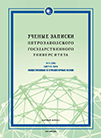ДЕЯТЕЛЬНОСТЬ РУССКОЙ ПРАВОСЛАВНОЙ ЦЕРКВИ
ПО УВЕКОВЕЧЕНИЮ ПАМЯТИ ПОГИБШИХ МОРЯКОВ «КУРСКА»
THE RUSSIAN ORTHODOX CHURCH ACTIVITIES ON MEMORY PERPETUATION OF THE SAILORS PERISHED ON BOARD OF “KURSK” SUBMARINE
Author(s): Irina Alekseevna RazumovaSubject(s): History, Cultural history, Museology & Heritage Studies, History of ideas, Local History / Microhistory, Military history, Recent History (1900 till today), Theology and Religion
Published by: Петрозаводский государственный университет
Keywords: social memory; memorial objects; the wreck of “Kursk”; religious cult; the Orthodox Church
Summary/Abstract: The article is concerned with the problem of constructing a phenomenon of social memory on the example of one historical event – the wreck of the nuclear submarine “Kursk” in the Barents Sea waters. The disaster occurred on the 12th of August, 2000. An important role in the memorialization of the tragic event, which resulted in the death of 118 sailors, was played by the clergy of Murmansk and Monchegorsk eparchy belonging to the Russian Orthodox Church. The erection of the memorial complex, renovation of the local relics, and their popularization in the process of religious education contributed to the strengthening of the local diocese’s position and its leadership role in the Russian Orthodox Church, society, and the state. The undertaken steps also helped to enhance the ties between the Russian Orthodox Church and the Navy of the Russian Federation. The undertaken works on the memorial complex implementation have grown into one of the important factors in the development of the Church infrastructure in the region. The Seraphim cemetery of St. Petersburg has become the central place of remembering the fallen sailors. Liturgical services in memory of the perished submariners are conducted in different cities and districts of the country. The process of veneration manifests itself in the creation of Orthodox memorial objects and conducted memorial campaigns. The article is based on the set of religious and secular sources including earlier published texts and online resources.
Journal: Ученые записки Петрозаводского государственного университета. Общественные и гуманитарные науки
- Issue Year: 2016
- Issue No: 5 (158)
- Page Range: 7-12
- Page Count: 6
- Language: Russian

